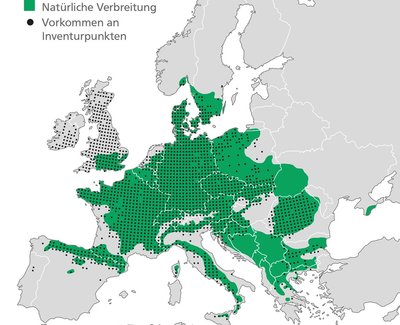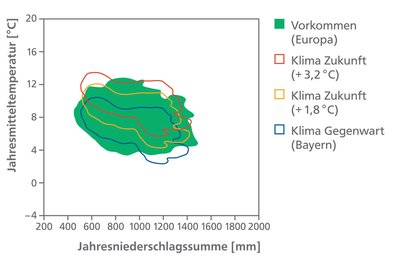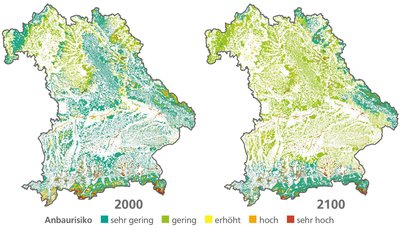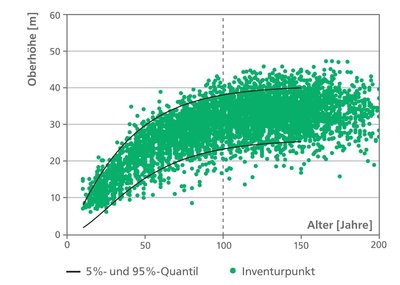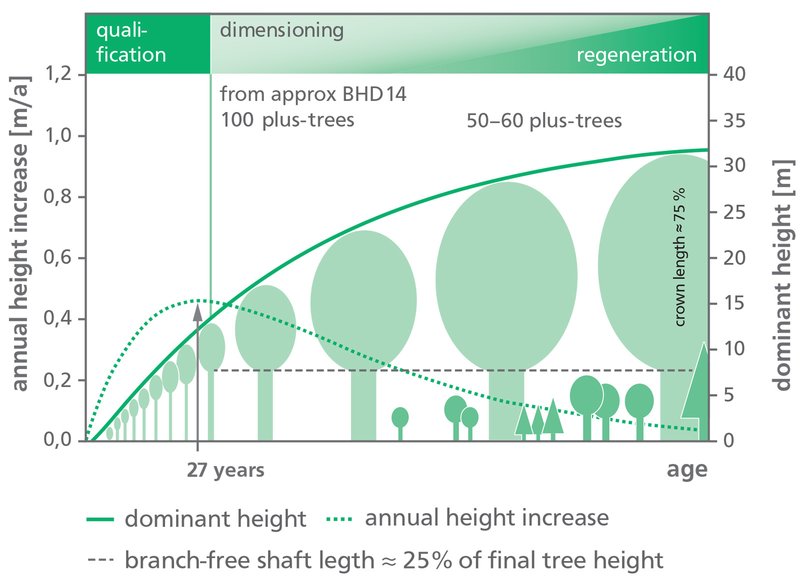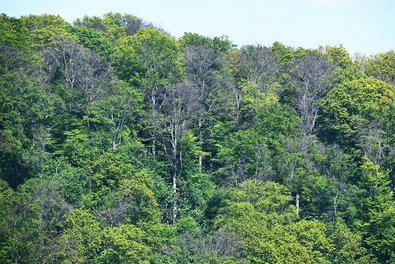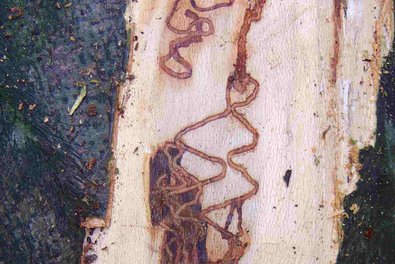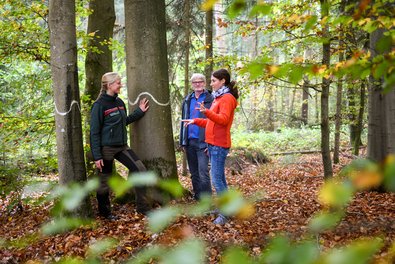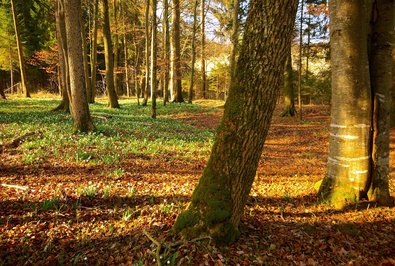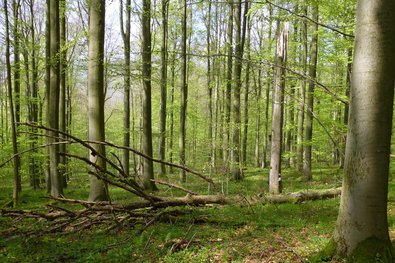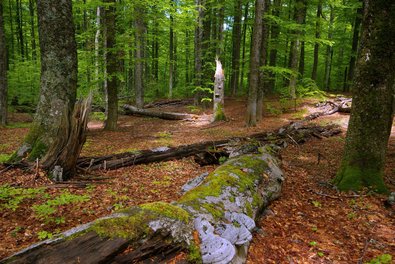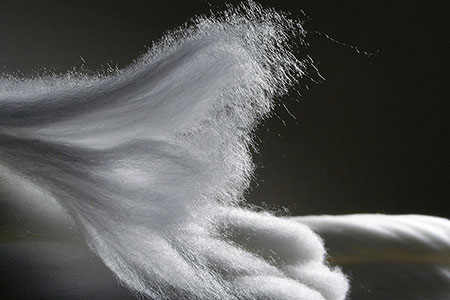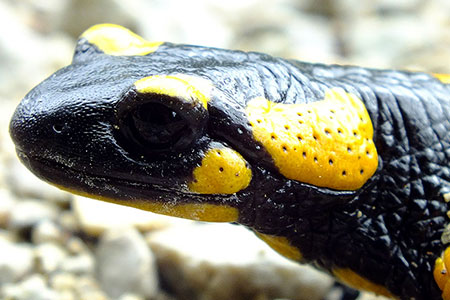Distribution
The natural range of the beech stretches from the Atlantic in the west to the Black Sea in the east, and from southern regions of Scandinavia to Sicily. It is thought, however, that the natural spreading of the beech has not yet concluded. Its altitude limit is just above sea level in Scandinavia, but rises the further south you go. On Sicily the beech grows at up to 2.250 m above sea level. With a total of 338.000 ha, Bavaria has the largest area of beech-cover in Germany, comprising 14 % of the entire forest area in Bavaria.
Climate and cultivation risk
The beech prefers oceanic, humid climates with relatively mild winters, but also occurs in cooler mountainous areas as a tree species of mixed mountain forests. Bavaria’s climate is the optimum climate for beech, and this will remain the case in the future, too. If there is a higher rise in temperature, however, the tolerance threshold for beech will be exceeded in the warmest areas (e.g. Kitzingen and at the Chiemsee lake in southern Bavaria).
The eastward spread of beech is limited by winter temperatures and levels of precipitation that are too low. January temperatures of below -7 °C are not typical for this tree species. Its warm-dry range limit is in Romania. The warmest areas where beech occurs are for example the Crimean peninsula and the northern coast of France.
The prognosis for the beech in times of climate change varies. Bavaria currently offers the optimum climate for the beech. Its suitability for cultivation is limited only in the driest and warmest areas in the future, such as the southern Franconian plateau. In higher areas in the mid-range mountains and the Alps, it is possible that the beech will spread and become more competitive.
Water and soil
The beech reacts sensitively to alternating wet-dry, water-logged, and very acidic soils. Here they only develop roots in the upper layers of soil and are thus less stable, despite their heart root system. Sites that can be excluded for cultivation are those with soils that are regularly flooded or with high levels of groundwater.
The beech thrives on a wide range of nutrients. It grows both on alkaline-rich chalk and on acidic silicate rock. It avoids rocky ravines and scree forests, heavy clays and pure sandy soils in summer drought areas. Its litter decomposes easily and helps improve the soil.
Because of its ecological properties, the beech occupies very large areas. It is naturally disposed to form pure stands. It only becomes less competitive and allows other tree species to assert themselves on soils that are too wet, too dry or too acidic. It grows best on medium to deep, fresh, loose, alkaline loamy soils rich in nutrients and with sufficient precipitation in the summer months.
Silviculture with beech
The beech is one of the commercially most important deciduous hardwoods in central Europe. It is a highly productive tree species on almost all sites. One special feature is its high elasticity lasting into old age, resulting in a very long growth period. A decline in its growth performance is not to be expected. It cannot however compete with the spruce, reaching just 70 % of the volume growth of the spruce. The focus is thus on spreading the ecological and economic risk, which is achieved by selecting suitably adapted tree species in mixed stands.
The beech regenerates well in many places. Its ability to tolerate shade in early years and to cast a lot of shade in old age makes the beech the most competitive species in central Europe. It is however sensitive to frost and does not cope well with heat in early summer.
Silviculture with beech - a brief summary:
- Regeneration: There should be preplanting or beech should be sown under the canopy to avoid unfavourable tree shapes. On clear areas, regenerate should only be with protection from the side, on slopes with cold air drainage, or under a sparse pioneer crop. In the case of natural regeneration, there should be targeted cutting of the tree canopy to allow appropriate quantities of light at the right time depending on the desired mix of tree species and their proportions.
- Tending: 100 – 150 potential plus trees (options) should be safeguarded early, including additional tree species for a mixed stand (distance between potential plus trees 8 – 10 m). Towards the end of the qualification phase, moderate action should be taken to promote 100 - 150 options. Severe intervention in the tree canopy should be avoided to ensure branches low down on the trunk continue to die off (to enhance timber quality). There should only be intervention when the options are at risk.
- Thinning: Once a trunk shaft length of 6 - 8 m free of live branches or a BHD of 14 cm has been reached, the options should be reduced to 100 plus trees (10 m apart) and their strongest competitors should be removed to give them plenty of light. Later in the dimensioning phase, just 50 - 60 plus trees should be promoted (> 13 m apart). The plus trees should be inspected every 5 years and intervention made where necessary.
Timber use
The beech is the most important deciduous hardwood in central Europe in terms of timber utilisation.
- Wood properties: The wood has fine pores and is homogeneous. The sapwood and heartwood are the same colour, and pale yellow to reddish white. In old timber there can be colouring in the centre. The timber is heavy (density approx. 720 kg /m³) and heavier than oak. Its high resistance to abrasion and wear means it can be used in heavy-duty applications.
- Workability: The timber responds very well to steam-bending. It machines, slices and peels well. It is not weather-resistant, but easy to impregnate.
- Areas of use: Beech is an important timber in furniture-making. In the building industry, beech fulfils the strength requirements for construction wood products with even lower dimensions than those we know from coniferous timber. Products include glued laminated timber (glulam), beams, boards, and panels made from beech laminated veneer lumber. Beech wood pulp provides the cellulose for premium quality papers and for viscose fibre for the textiles industry. As a wood material for medium-density fibreboard, it offers better quality results for deep milling than coniferous wood. Beech is a very important timber in the fuel wood sector. Current research in the field of bioeconomy is focused on future-oriented applications, with a view to replacing fossil resources with renewable raw materials.
Forest conservation
The conservation status of the beech is not at risk at the moment. There is however a serious complex disease that can afflict beech, known as beech bark disease. Beech bark disease is caused by a combination of damage caused by the beech scale (Cryptococcus fagisuga), which sucks sap from the parenchyme tissue of the bark, the subsequent infestation by bark funghi of the genus Nectria, and infestation by wood rot-causing fungi such as the tinder fungus (Fomes fomentarius). The beech is also highly susceptible to sunburn damage. The importance of the beech splendour beetle (Agrilus viridis) among bark-breeding insects is often underestimated. This species in particular benefits from summer dry spells and often causes crown dieback. Bark-breeding bark beetles (Taphrorhychus bicolor and Ernoporus fagi), on the other hand, have so far been of secondary importance. Beech stands can be badly damaged by browsing and bark stripping where the hoofed game populations are too high.
Species diversity
Beech is to be found in almost all forest societies. The most important beech forest societies are: woodrush-beech (Luzulo-Fagetum), sweet woodruff-beech (Asperulo-Fagetum), forest barley-beech (Hordelymo-Fagetum) and orchid-beech forest (Cephalanthero-Fagion). With beech it is important to preserve habitat trees and standing, thick-diameter deadwood. Where there are lots of cavities and niches, collared flycatchers (Ficedula albicollis) or even red-breasted flycatchers (Ficedula parva) may occur. A total of up to 70 bird species breed in the beech forests of central Europe. Characteristic species are the wood warbler (Phylloscopus sibilatrix), the black woodpecker, and the subsequent occupiers of its large cavities, the stock dove (Columba oenas) and brown owl (Strix aluco). In old-growth forests rich in structures, the middle spotted woodpecker is a keystone species. No other deciduous tree in central Europe is associated with as many different fungal species as the beech. In addition to mycorrhizal partners such as the beech milk cap (Lactarius subdulcis), numerous deadwood fungi such as the coral tooth fungus (Hericium coralloides) are to be found on beech wood. The beech is the preferred host tree of almost 30 herbivorous beetle species and more than 70 butterfly species. The only monophagous xylobiontic species dependent on the beech (i.e. exclusively dependent species) is the beech splendour beetle, and of the phytophagous beetle species it is only the larvae of the beech leaf-miner beetle (Orchestes fagi) that are monophagous.
Brief profile of the common beech (Fagus sylvatica)
- Maximum age: Approx. 500 (900) years old
- Shape: Up to 45 m high, BHD up to 2 m; where freestanding, has low branches and broad crowns.
- Shoots: Pale green and elastic; once lignified, purplish brown with lots of lenticels.
- Buds: Alternate; slim, pointed, torpedo-shaped; leaf buds up to 3 cm long and 4 mm thick; flower buds have more of a belly; small narrow scales, reddish to light brown.
- Leaves: Alternate; pointed ovate with a crenate edge, more wedge-shaped towards the rounded base, crenate to the tip; shiny green, lighter on the lower side; initially with soft hairs and ciliated, almost bare of these when older; brownish to yellowish red autumnal discolouration.
- Bark: Initially grey brown, shiny and smooth, later grey to whitish grey; up to 15 mm in diameter; normally smooth bark; rarely may become rough; branches that have dropped off form scars with the shape of a “mandarin’s moustache”.
- Blossom: Flowers from April to May, with the sprouting of the first leaves; monoecious; inconspicuous and light green; between leaf stem and twig; wind and insect-pollinated.
- Fruit: Beechnuts or mast: 1-2 cm long and just under 2 cm in diameter; two to be found in a fruit cluster; sharply three-sided and shiny brown; weight of a thousand seeds between 190 and 220 g; spread by squirrels and mice, among others.
- Root growth: Heart root system with intensive root-building at the foot of the tree; high proportion of fine hair roots.

